9
I have a form where I need to fill out a DataGridView with data from a user list. To generate this data, I used 3 classes:
User class
namespace TesteDataGridView
{
public class Usuario
{
public int id { get; set; }
public string login { get; set; }
public string nome { get; set; }
public Perfil perfil { get; set; }
public Usuario()
{
//Cada usuario que eu crio obrigatoriamente já cria seu perfil
perfil = new Perfil();
}
}
}
Class User List
using System.Collections.Generic;
namespace TesteDataGridView
{
public class ListaUsuarios : List<Usuario>
{
}
}
Class Profile
namespace TesteDataGridView
{
public class Perfil
{
public int id { get; set; }
public string descricao { get; set; }
}
}
Form Archive:
using System;
using System.Windows.Forms;
namespace TesteDataGridView
{
public partial class Form1 : Form
{
ListaUsuarios lstUsr; //Cria uma lista de usuários
public Form1()
{
InitializeComponent();
//Instancia a lista de usuários
lstUsr = new ListaUsuarios();
//Não habilita a geração a
dgv.AutoGenerateColumns = false;
}
private void btnCriaListaUsuarios_Click(object sender, EventArgs e)
{
//cria alguns usuários e adiciona na lista
Usuario u1 = new Usuario();
u1.id = 1;
u1.login = "usr1";
u1.nome = "usuario1";
u1.perfil.id = 3;
u1.perfil.descricao = "operador";
lstUsr.Add(u1);
Usuario u2 = new Usuario();
u2.id = 2;
u2.login = "usr2";
u2.nome = "usuario2";
u2.perfil.id = 2;
u2.perfil.descricao = "lider";
lstUsr.Add(u2);
Usuario u3 = new Usuario();
u3.id = 3;
u3.login = "usr3";
u3.nome = "usuario3";
u3.perfil.id = 1;
u3.perfil.descricao = "administrador";
lstUsr.Add(u3);
}
private void btnPreencheGrid_Click(object sender, EventArgs e)
{
dgv.DataSource = null; //Limpa o grid;
dgv.DataSource = lstUsr;
dgv.Refresh();
}
}
}
In my DataGridView, on the property DataPropertyName, i configure as follows the name of the columns and what should be presented in them:
Column1 - ID do Usuário => DataPropertyName: id;
Column2 - Nome do Usuário => DataPropertyName: nome;
Column3 - Login do Usuário => DataPropertyName: login;
Column4 - Perfil do Usuário => DataPropertyName: perfil.descricao;
With the first 3 columns, fine, but the profile column, is not filled leaving my datagridview like this:

I found a solution, where they talked to override the method toString of the Profile class and configure the DataPropertyName column 4 as "profile", but I didn’t find it very cool, see:
namespace TesteDataGridView
{
public class Perfil
{
public int id { get; set; }
public string descricao { get; set; }
// Solução encontrada, fazer um override no método ToString()
// Não achei muito legal... :(
public override string ToString()
{
//return base.ToString();
return descricao.ToString();
}
}
}
Where am I going wrong?
Perfect Omni, worked exactly as I needed.
– Emerson